A grey horse is a horse with fur that ranges from nearly white to a dark charcoal-grey. Sometimes, grey horses have spots called dapples. Their manes ranging in color from pale white to slate black. Usually, the mane is a shade or two darker than a grey horse’s body coat.
One of the most interesting things about grey horses is that they are never born grey! Grey fur is the result of a progressive loss of pigment in the horse’s coat- a horse that will be silvery grey as a 10-year old could be born as a black, bay, sorrel, palomino, or even spotted horse!
Grey Horses Change Color over Time
These images were taken of the same horse 10 years apart!
Notice how facial greying and light dapples appear on the horse as a yearling (left) but the greying progresses to near-white fur by age ten (right)

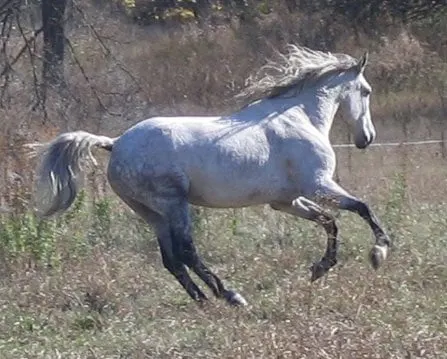
Grey Horses: Rarity & Pricing
Recently, our team combed through thousands of for sale ads on the internet’s top 3 horse sales sites. We analyzed the data and here’s what we learned about grey horses:
- Roughly 8.2% of horses are grey, according to our study of horses for sale.
- The average asking price for a grey horse for sale in 2023 is $10,500 USD. The average asking price of all horses for the same time period is $9,500.
- This means grey horses are 10.5% more expensive than the average horse.
- Our study found that grey horses are most popular for dressage and trail riding. They are least popular for Western competitions like barrel racing and Western Pleasure.
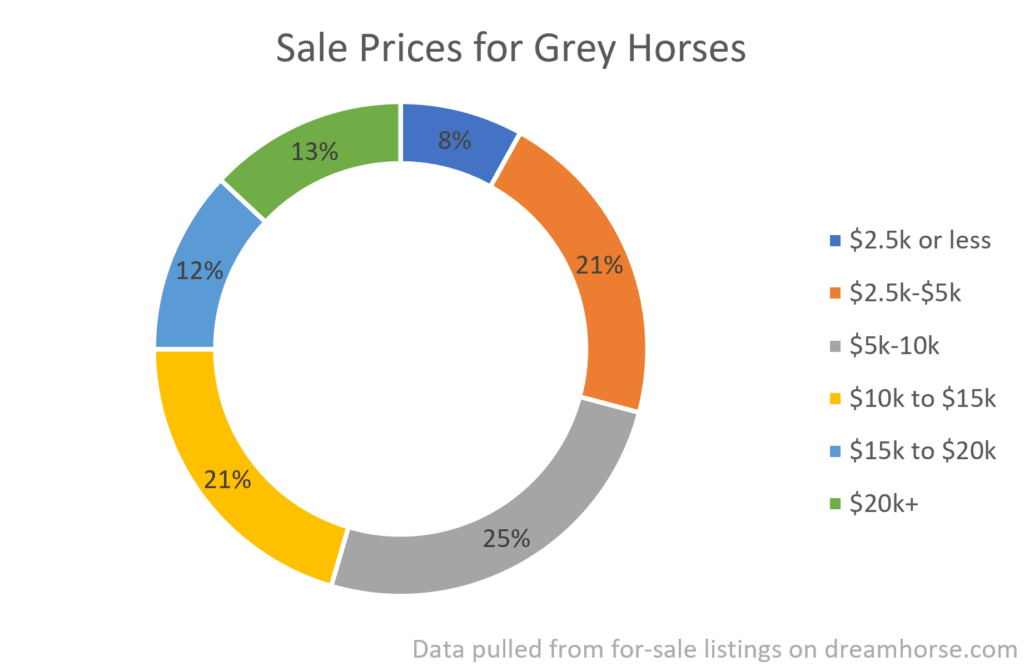
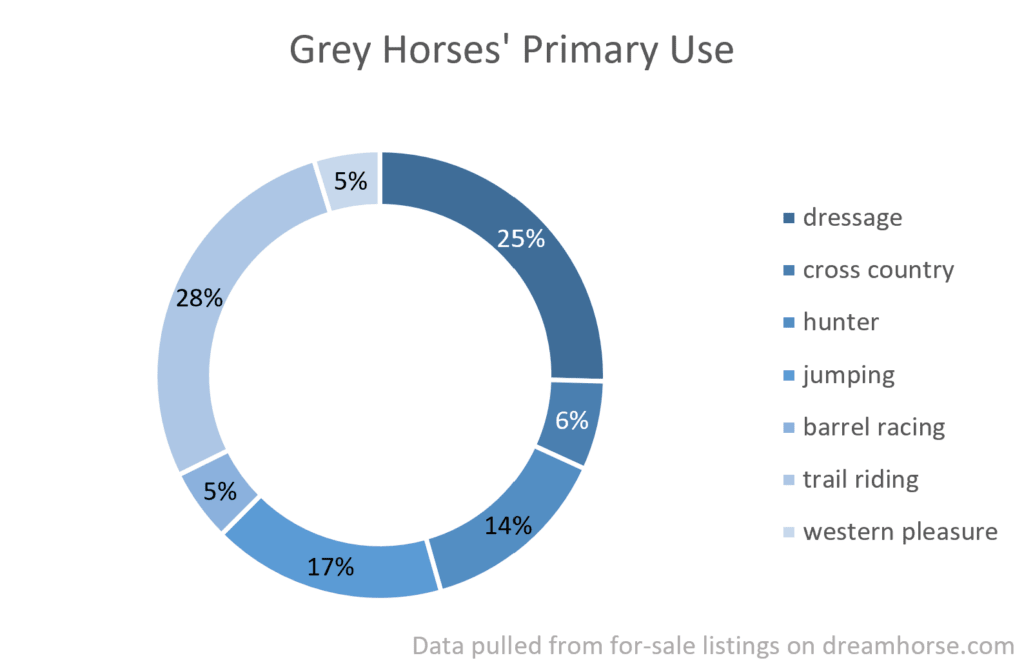
Grey Horse Genetics
According to the Veterinary Clinics of North America, the grey color is the result of a gene mutation, referred to as, STX17G. 1 STX17G modifies the behavior of melanocytes (responsible for color) and causes a horse’s coat to slowly de-pigment. This gene mutation can also contribute to the development of melanomas and vitiligo.1 Horses with two copies of this gene tend to turn grey faster2. Percherons, however, grey more slowly- with dapples occurring later than in other breeds- at around 8-9 years old.2
According to the University of Minnesota College of Veterinary Medicine, melanomas are so common in older grey horses that approximately 80% of grey horses older than 15 years old have or have had melanoma.3 The tail, belly, eyelids, and muzzle are the most common location for cancerous tumors.
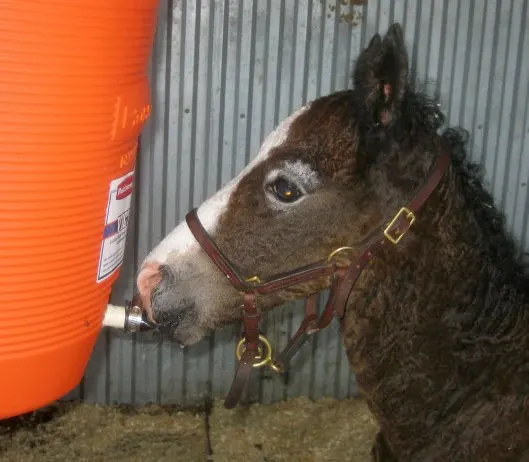
Although horses don’t turn grey until they are older, it’s usually easy to predict the presence of the greying gene.
In the photo here, you can see the classic first indicator of grey: a circle of white fur around each eye, on a curly horse foal.
Breeding Grey Horses
Breeding for color is controversial these days because most horse enthusiasts believe horses should be bred for health and temperament first. Most people get a grey horse by purchasing a horse with the grey gene, but some breeders intentionally breed grey horses by breeding two grey horses together (which has at least a 75% chance of producing a grey foal) or by breeding two horses of a breed where almost all horses of the breed are grey – such as Lipizzaner, Percheron, and Andalusian horses.
Grey Horse Folklore
Historically, grey horses were believed to possess calm dispositions and agreeable personalities.4 However, just like the folklore that chestnut mares are harder to handle, research studies have been unable to prove this theory.
Historically, grey horses were in such demand as carriage horses that entire breeds of exclusively grey horses were created. All-grey horse breeds include Percherons and Lipizzaner.
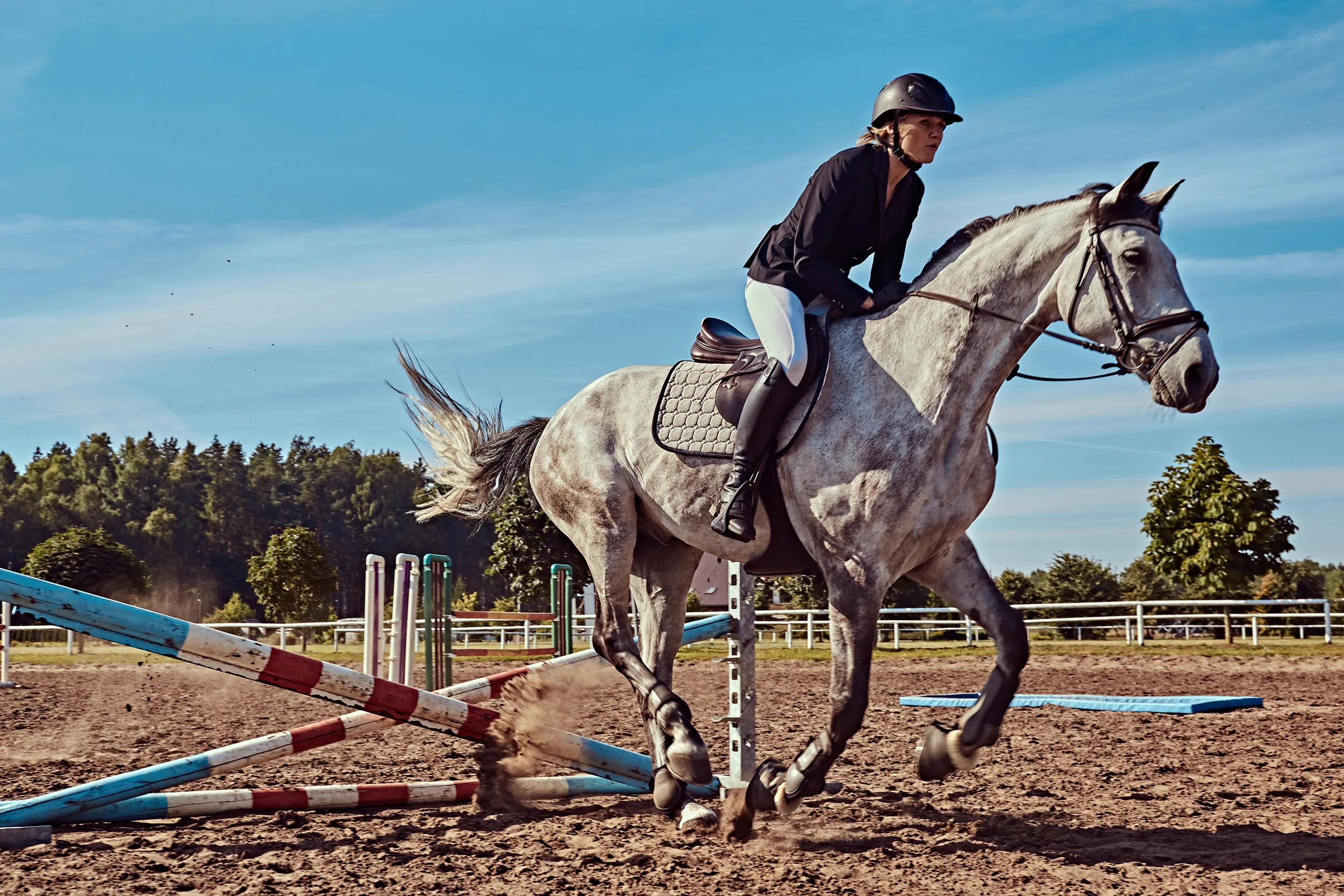
Grey Horses in History
Grey horses have been prized throughout history. In the Victorian era, owning a grey horse was seen as a status symbol among the upper class. Families with income to be picky about their carriage horses often preferred grey horses- not only for style but also because white horses are more visible at night. This is because their coat reflects more light.5
Variations of a Grey Horse Coat Coloring:
Grey horses come in vastly different shades, patterns, and expressions. Here are some of the most common types of grey horses:
Dapple Grey
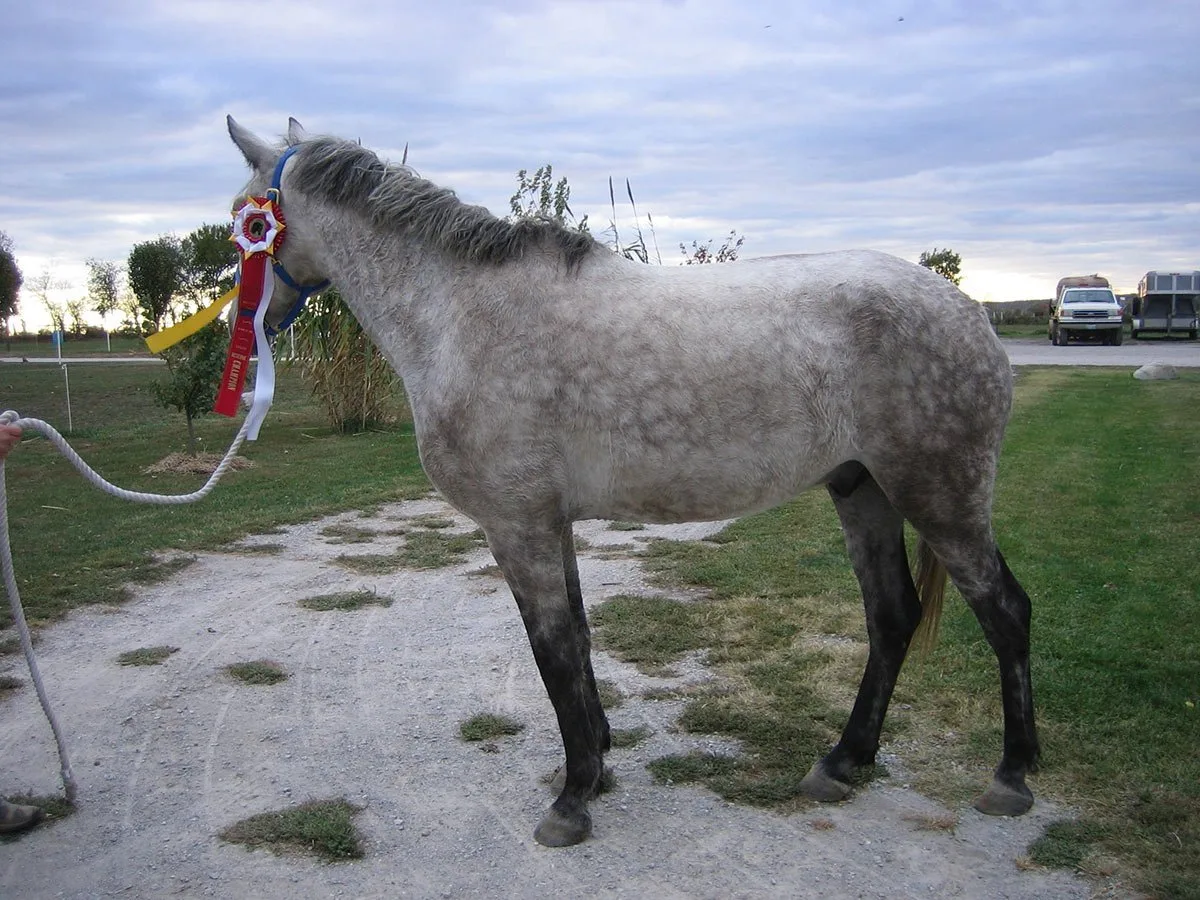
Dapple grey horses feature a pattern of slightly lighter-colored rings or circles on a darker grey coat.
Dapples show up best in sunlight when a horse is clean.
Dapple grey is temporary color, and all dapple grey horses will, within a few years, lose their dapples as their coat fades to pale grey or white. Not all grey horses will develop dapples during their greying process, but if they do it is most likely between the age of 2-5
Fleabitten Grey


Flea-bitten grey horses look like they have freckles.
For flea-bitten grey horses, the greying process can change their coats such that tiny groups of hair remain fully pigmented on an otherwise fully grey or white coat.
These flecks are distinct from Appaloosa spots because the marking is not visible in the pigmentation of the skin – only on the horse’s fur.
Dapple grey and flea-bitten grey are the terms most common types of grey horses. In recent years, however, riders and breeders have begun referring more often to “steel grey,” “rose grey,” and “grey roan” and other variations. Each of these terms simply refers to a slight variation in how the grey gene is modifying the underlying base color.
Rose Grey

Rose grey can be a temporary stage of the greying process. Horses with a base coat color of chestnut or bay (i.e. a brown coat) may experience the greying process as white fur evenly distributed through their coat. This mixed appearance of brown and white hairs can appear to be a pinkish or gold color, creating a beautiful– though fleeting- rose grey colored horse.
Rose grey horses can also have dapples on their grey coats. Like dapples, rose grey may last only 1-2 years before the depigmentation progresses to overtake the red or brown fur.
Steel Grey
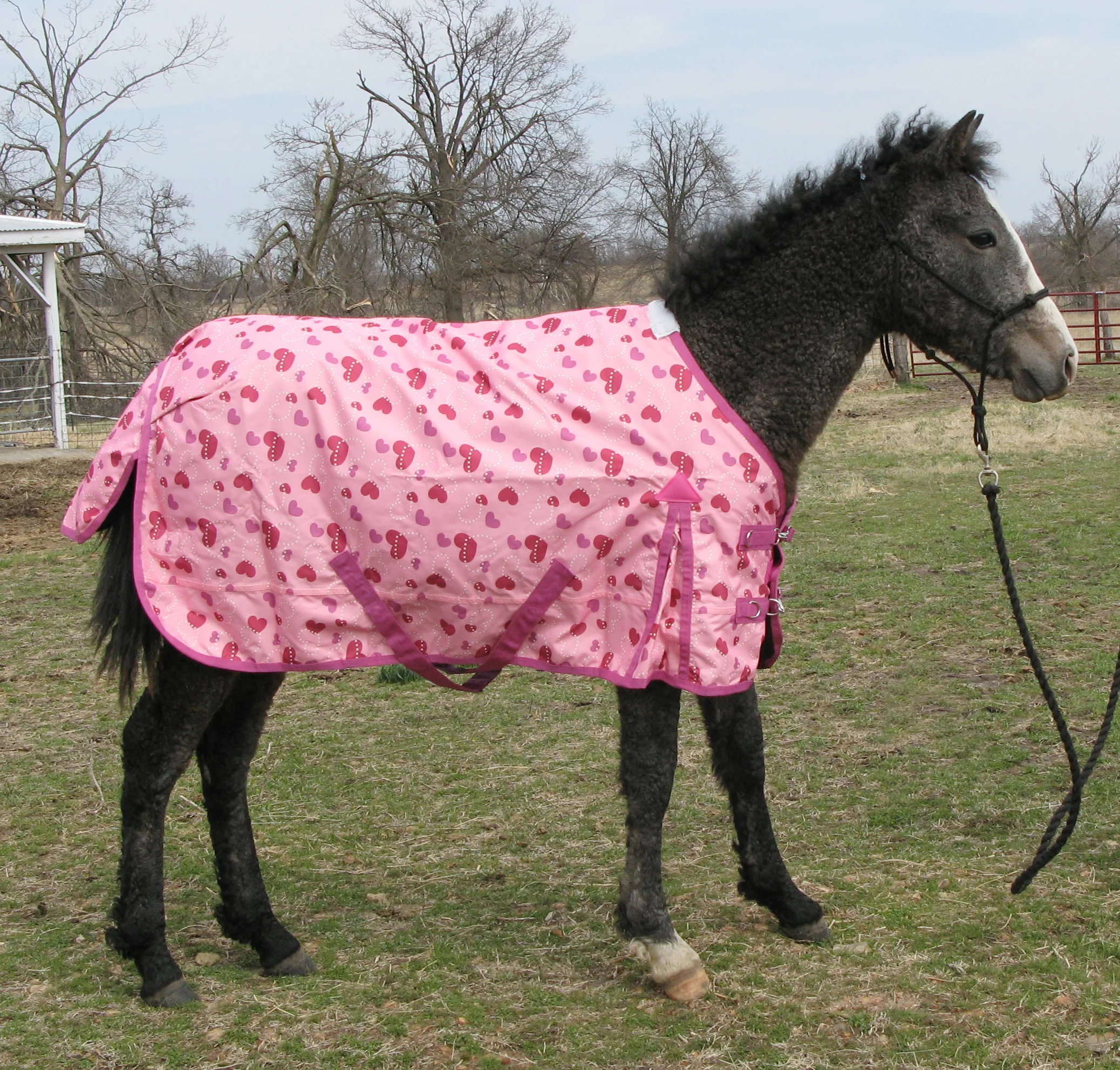
Sometimes called iron grey, steel grey horses have coats displaying a dark, gunmetal–like variation of grey. Steel grey occurs when a horse that is born black begins to experience the depigmentation action of the grey gene. While much of the coat retains dark black pigment, some fur grows in grey or white- leading to a “steel grey” appearance.
Because UV light can damage coats and change how light reflects on a dark coat, steel grey horses who spend a lot of time in direct sunlight may appear rose grey in some areas.
Grey Roan
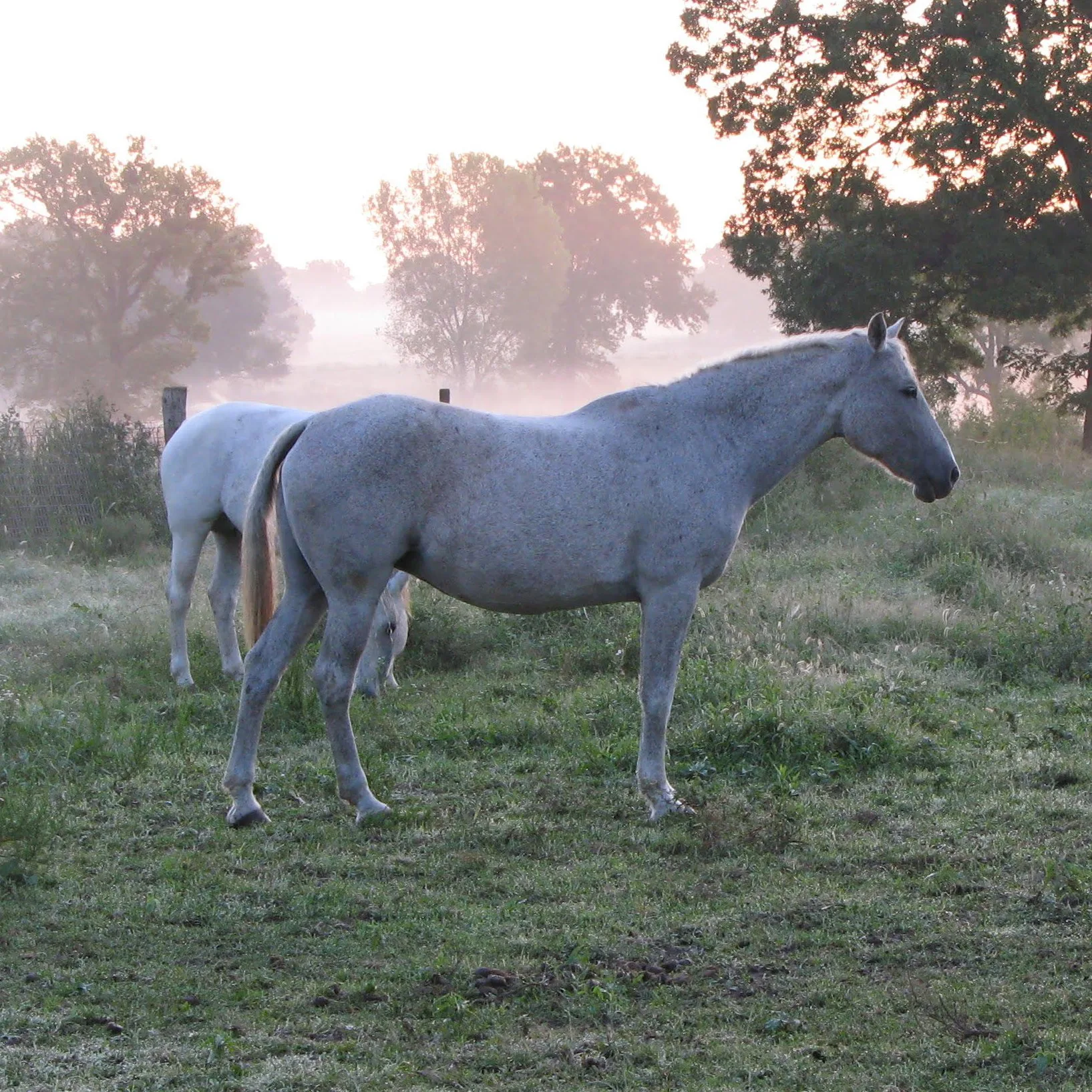
While the colors described above are always variations of how a grey gene is expressed, the term “grey roan,” is more difficult to describe because it can refer to colors that are very different genetically, but very similar in appearance.
“Roan” is a coat color in which white fur and colored fur intermix on a horse’s body. When roan exhibits on a black horse, the effect of the roan gene can create a nearly identical appearance to a genetically grey horse, called blue roan. However, in the case of a roan, the white fur is not the result of a mutation, but rather a standard genetic color modifier,
Roan horses, unlike grey horses, will not fade to white with time but will remain the same color from year-to-year. Roan horses also tend to retain their base color on their face, legs, tail, and mane, with white or grey fur only on the large areas of the body.
Interestingly, horses can carry both the gene for Roan and grey at the same time. If you suspect this kind of complex coat coloring on your horse, getting a genetic color test may provide clarity. Alternately, you can carefully track the horse’s pedigree to determine what genes the horse could carry.
What is a grey horse called?
Grey horses are referred to by several names. While it’s correct to call a grey horse simply “a grey horse” (spelling it “gray” is also equally correct), there are specific names for different variations of grey coats. For example, rose grey horses, flea-bitten grey horses, dapple grey horses, steel grey, or grey roan. Keep reading to learn about these specific types of grey horse colors.
Are grey horses born grey?
Our research found that about 8% of horses are grey, this makes grey horses unusal but not rare. The grey gene slowly changes the color of the horses coat, through depigmentation, as the horse ages. Pale grey horses are generally older, while dark grey horses are younger – though the rate at which each grey horse turns grey varies from individual horse to individual horse.
One way that breeders tell if a newborn horse will turn grey is by checking the fur around the foal’s eye. Foals that have the grey gene usually have a ring of white or grey fur around each eye. Breeders look at this as a marker to predict the presence of a grey gene. According to UC Davis– which offers a genetic test for the presence of the grey gene – grey horses typically turn white by age 6 to 8 years old
Are grey horses rare?
Our research found that about 8% of horses are grey, this makes grey horses unusal but not rare.
Grey horses are unusual because, due to how color fades slowly, a grey horse is only visibly grey for 3 to 4 years of their life. Before they turn grey they are generally the base coat color they were born with. After the grey gene’s depigmentation process completes, at 6 to 8 years old, genetically grey horses appear white or fleabitten (speckled) white.
The prevalence of the grey gene varies between horse breeds. In some breeds- like Lipizzaner, Percheron, and Andalusian- which are already somewhat rare breeds- the grey gene is common.
Why are white horses called grey?
Most white horses are older grey horses or- rarely- albino horses. Describing horses white isn’t technically accurate because there’s no gene* that could make a horse genetically “white”- only grey or albino. Because of this, grey horses that with coats that have fully depigmented – turning them white – are still referred to as grey horses. Generally these horses retain a grey tint due to darker skin underneath their white fur. Even though the horse may appear white, darker pigmentation can be seen where the fur thins around the eyes and muzzle of the horse.
*When paint or pinto horses with prominent white markings called called “frame overos” are bred together, there is a chance the offspring will be solid white. Sadly, foals born white due to this genetic condition never survive, and the condition is known as Lethal White Overo Syndrome
At what age does a grey horse turn white?
According to University of California at Davis – one of the leading equine genetics labs – grey horses typically complete the depigmentation process and become fully white by age 6-8, though some horses may turn white more rapidly or remain grey past the age of 10.
- MacKay, R. J. (2019). Treatment options for melanoma of gray Horses. Veterinary Clinics: Equine Practice, 35(2), 311-325. [↩] [↩]
- Bellone, R., Sponenberg, D. P. (2017). Equine Color Genetics. Germany: Wiley. pg 6-13 [↩] [↩]
- College of Veterinary Medicine. Leatherdale Equine Center. Gray Horse Melanoma [↩]
- Bellone, R., Sponenberg, D. P. (2017). Equine Color Genetics. Germany: Wiley. pg 6-13 [↩]
- J. P. Straley and S. S. Kovash. 2000. Physics of Light. The Department of Physics & Astronomy at University of Kentucky. [↩]
